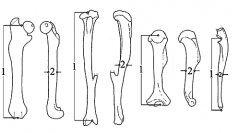

 Comptes Rendus Palevol
13 (4) - Pages 297-306
Comptes Rendus Palevol
13 (4) - Pages 297-306The genus Hypnomys Bate, 1918 includes some endemic Neogene chronospecies from Mallorca and Menorca, evolved in insularity conditions from the Lower Pliocene to the human arrival at the archipelago. The study of the allometric proportions (functional length and sagittal diameter) of the limbs’ long bones of Hypnomys eliomyoides Agusti, 1980 (Lower Pleistocene of Menorca), Hypnomys sp. (Pleistocene of Menorca), Hypnomys onicensis (Reumer, 1994) (Upper Pliocene-Lower Pleistocene of Mallorca) and Hypnomys morpheus Bate, 1918 (Upper Pleistocene of Mallorca) only indicates small differences with the garden dormouse (Eliomys quercinus Linnaeus, 1776) and other mainland rodents and insectivores. The study about the locomotion type by means of Similarity Matrix of Bou indicates that 1) Hypnomys spp. presents the greater similarities with the arboreal, jumping and gliding species; 2) the jumping and digging life style of Hypnomys spp. are more developed (25%) than in E. quercinus ; 3) the walking locomotion of Hypnomys spp. is only a 7% greater than in E. quercinus ; and 4) the degree of similarity with the gliding locomotion of Hypnomys sp. is greater (17%) than in E. quercinus . Some of this data indicates that Hypnomys spp. was better adapted to the arboreal life than E. quercinus, due to the relationship between the jumping and gliding capacities with the arboreal locomotion. The greater similarity of Hypnomys spp. with the walking locomotion does not necessarily involve more terrestrial habits. Our interpretation contrasts with earlier conclusions of Hypnomys life style (Hypnomys cf. onicensis and Hypnomys morpheus) where the terrestrial locomotion was overestimated in front of the arboreal locomotion. The locomotion type of Hypnomys would be related with the presence of important forest masses on the Balearic Islands during the Neogene, a different degree of environmental stress from that of the mainland ecosystems and a probable expansion of the ecological niche occupied by these species.
Neogene insular faunas, Western Mediterranean, Similarity matrix of Bou, Locomotion trends, Ecological niche, Birds of prey